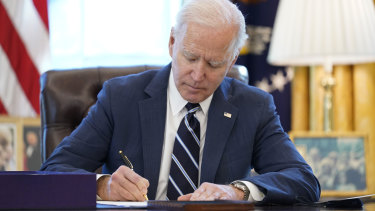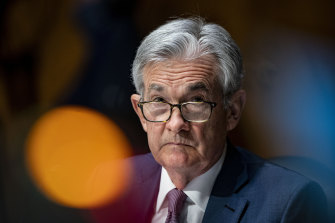How much stimulus is too much? Biden’s relief bill may have a nasty sting
How much stimulus is too much? That is the question US Federal Reserve chairman Jerome Powell will be asked at next week’s press conference.
As President Biden signs into law one of the largest economic rescue packages in US history, the chair of the Federal Reserve will have his work cut out trying to soothe nerves building on bond markets.
The central bank is expected to give a relaxed stance on inflation fears at next week’s meeting but doubts continue to grow. Economists predict that Biden’s $US1.9 trillion ($2.5 trillion) stimulus package will be a game changer for the American economy, while bond yields have rocketed in recent months as investors prepare for higher rates.
“Monetary and fiscal policy are conducting a grand experiment with their aggressive measures,” says Bernd Weidensteiner, economist at Commerzbank. “Risks of overheating are written in small print.”
US President Joe Biden as he signed the American Rescue Plan, a coronavirus relief package, in the Oval Office of the White House on Thursday.Credit:AP
The passage of the latest COVID relief bill through US Congress this week marked a huge victory for the president, giving the green light to a fresh round of $US1400 cheques for most adults and a $US300 boost to weekly unemployment benefits.
But it could come with a nasty sting in the tail. The stimulus is enormous at 8.5 per cent of US GDP and that could cause the Fed’s rate-setters major headaches later this year.
Goldman Sachs now expects growth in the world’s largest economy to hit almost 7 per cent this year with the boost so big it will spill over to other economies. The package will increase GDP by 0.6 per cent in the UK and 1.1 per cent globally in the first 12 months, according to the OECD.
Federal Reserve chairman Jerome Powell has his work cut out for him to contain inflation.Credit:AP
Michael Pearce at Capital Economics says the Fed will use its statement to “push back on market expectations that rate hikes are rapidly coming into view. Officials appear to be setting the stage to look through any rebound in price pressures this year as transitory”.
Pressure could build on the rate-setters as the summer and reopening wears on, however. Pearce does not share the Fed’s confidence that “any upward move in inflation this year will prove temporary”, adding: “Wage growth is unusually elevated given the degree of spare capacity in the labour market and inflation expectations are trending higher.”
One key ingredient for inflation is still missing. Powell has pointed to high levels of unemployment as a hurdle to tightening policy with large numbers out of work likely to keep wage pressures low.
However, Treasury Secretary Janet Yellen believes full employment may be reached as soon as next year. That would mean a much faster jobs recovery than the aftermath of the financial crisis.
Another jolt of stimulus could also be thrown into the mix. The latest package is aimed at just propping up incomes and businesses during the pandemic.
Biden promised to spend trillions of dollars more on his “Build Back Better” plan, including an infrastructure package that will spearhead his green agenda.
“Over the summer and into the second half of this year, I think we are going to have to see a change in stance from the Fed,” says Knightley.
The Daily Telegraph, London
Market Recap
A concise wrap of the day on the markets, breaking business news and expert opinion delivered to your inbox each afternoon. Sign up here.
Most Viewed in Business
From our partners
Source: Read Full Article



